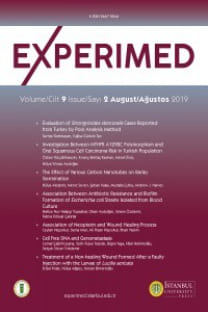Tek Basamaklı Ters Transkripsiyon Kantitatif PZR Yönteminin miRNA Ekspresyon Analizleri için Optimizasyonu
Optimization of One Step Reverse Transcription Quantitative PCR Method for miRNA Expression Analyses
___
- 1. Lee RC, Feinbaum RL, Ambros V. The C. elegans heterochronic gene lin-4 encodes small RNAs with antisense complementarity to lin-14. Cell. 1993; 75(5): 843-54. [CrossRef ]
- 2. Vishnoi A, Rani S. MiRNA Biogenesis and Regulation of Diseases: An Overview. Methods Mol Biol. 2017; 1509: 1-10. [CrossRef ]
- 3. Ha M, Kim VN. Regulation of microRNA biogenesis. Nat Rev Mol Cell Biol. 2014; 15(8): 509-24. [CrossRef ]
- 4. Michlewski G, Caceres JF. Post-transcriptional control of miRNA biogenesis. RNA. 2019; 25(1): 1-16. [CrossRef ]
- 5. Kozomara A, Birgaoanu M, Griffiths-Jones S. miRBase: from mic-roRNA sequences to function. Nucleic Acids Res. 2019; 47(D1): D155-D62. [CrossRef ]
- 6. Alles J, Fehlmann T, Fischer U, Backes C, Galata V, Minet M, et al. An estimate of the total number of true human miRNAs. Nucleic Acids Res. 2019; 47(7): 3353-64. [CrossRef ]
- 7. Hydbring P, Badalian-Very G. Clinical applications of microRNAs. F1000Res. 2013; 2: 136. [CrossRef ]
- 8. Yan J, Zhang N, Qi C, Liu X, Shangguan D. One-step real time RT-PCR for detection of microRNAs. Talanta. 2013; 110: 190-5. [CrossRef ]
- 9. Androvic P, Valihrach L, Elling J, Sjoback R, Kubista M. Two-tailed RT-qPCR: a novel method for highly accurate miRNA quantificati-on. Nucleic Acids Res. 2017; 45(15): e144. [CrossRef ]
- 10. Tian T, Wang J, Zhou X. A review: microRNA detection methods. Org Biomol Chem. 2015; 13(8): 2226-38. [CrossRef ]
- 11. Xie S, Zhu Q, Qu W, Xu Z, Liu X, Li X, et al. sRNAPrimerDB: compre-hensive primer design and search web service for small non-co-ding RNAs. Bioinformatics. 2019; 35(9): 1566-72. [CrossRef ]12. Lu J, Getz G, Miska EA, Alvarez-Saavedra E, Lamb J, Peck D, et al. MicroRNA expression profiles classify human cancers. Nature. 2005 ;435(7043): 834-8. [CrossRef ]
- 13. Huang Z, Shi J, Gao Y, Cui C, Zhang S, Li J, et al. HMDD v3.0: a data-base for experimentally supported human microRNA-disease as-sociations. Nucleic Acids Res. 2019; 47(D1): D1013-D7. [CrossRef ]
- 14. Chen C, Ridzon DA, Broomer AJ, Zhou Z, Lee DH, Nguyen JT, et al. Real-time quantification of microRNAs by stem-loop RT-PCR. Nuc-leic Acids Res. 2005; 33(20): e179. [CrossRef ]
- 15. Saliminejad K, Khorram Khorshid HR, Soleymani Fard S, Ghaffari SH. An overview of microRNAs: Biology, functions, therapeutics, and analysis methods. J Cell Physiol. 2019; 234(5): 5451-65. [CrossRef ]
- 16. Robinson S, Follo M, Haenel D, Mauler M, Stallmann D, Tewari M, et al. Droplet digital PCR as a novel detection method for quantif-ying microRNAs in acute myocardial infarction. Int J Cardiol. 2018; 257: 247-54. [CrossRef ]
- 17. Li J, Yao B, Huang H, Wang Z, Sun C, Fan Y, et al. Real-time poly-merase chain reaction microRNA detection based on enzymatic stem-loop probes ligation. Anal Chem. 2009; 81(13): 5446-51. [CrossRef ]
- 18. Jin J, Vaud S, Zhelkovsky AM, Posfai J, McReynolds LA. Sensitive and specific miRNA detection method using SplintR Ligase. Nuc-leic Acids Res. 2016; 44(13): e116. [CrossRef ]
- 19. Mei Q, Li X, Meng Y, Wu Z, Guo M, Zhao Y, et al. A facile and specific assay for quantifying microRNA by an optimized RT-qPCR approa-ch. PLoS One. 2012; 7(10): e46890. [CrossRef ]
- 20. Benes V, Collier P, Kordes C, Stolte J, Rausch T, Muckentaler MU, et al. Identification of cytokine-induced modulation of microRNA expression and secretion as measured by a novel microRNA speci-fic qPCR assay. Sci Rep. 2015; 5: 11590. [CrossRef ]
- 21. Munafo DB, Robb GB. Optimization of enzymatic reaction conditi-ons for generating representative pools of cDNA from small RNA. RNA. 2010; 16(12): 2537-52. [CrossRef ]
- 22. Raymond CK, Roberts BS, Garrett-Engele P, Lim LP, Johnson JM. Simple, quantitative primer-extension PCR assay for direct mo-nitoring of microRNAs and short-interfering RNAs. RNA. 2005; 11(11): 1737-44. [CrossRef ]
- 23. Sharbati-Tehrani S, Kutz-Lohroff B, Bergbauer R, Scholven J, Eins-panier R. miR-Q: a novel quantitative RT-PCR approach for the expression profiling of small RNA molecules such as miRNAs in a complex sample. BMC Mol Biol. 2008; 9:34. [CrossRef ]
- 24. Benes V, Castoldi M. Expression profiling of microRNA using re-al-time quantitative PCR, how to use it and what is available. Met-hods. 2010; 50(4): 244-9. [CrossRef ]
- 25. Rai P, Kumar BK, Deekshit VK, Karunasagar I, Karunasagar I. Dete-ction technologies and recent developments in the diagnosis of COVID-19 infection. Appl Microbiol Biotechnol. 2021; 105(2): 441-55. [CrossRef ]
- 26. Wang J, Cai K, Zhang R, He X, Shen X, Liu J, et al. Novel One-Step Single-Tube Nested Quantitative Real-Time PCR Assay for High-ly Sensitive Detection of SARS-CoV-2. Anal Chem. 2020; 92(13): 9399-404. [CrossRef]
- Yayın Aralığı: Yılda 3 Sayı
- Başlangıç: 2011
- Yayıncı: İstanbul Üniversitesi
Umut KARABULUT, Dilay KARABULUT, Cüneyt KOCAŞ, Ayşem KAYA, Fahrettin KATKAT, Zerrin YİĞİT
Gülşen ALTINKANAT GELMEZ, Ufuk HASDEMİR, Güner SÖYLETİR
Seda SÜSGÜN, İlker KARACAN, Emrah YÜCESAN
Gülşen ALTINKANAT GELMEZ, Ufuk HASDEMİR, Güner SÖYLETİR
Ümit ÖZÇELİK, Eryiğit EREN, Yıldıray TUTPINAR, Devrim URUT, Mehmet TOKAC, Ayhan DİNÇKAN
Effects of Overexpression of ET-1 in Mammary Gland Physiology
Endokrin Bozucu Kimyasallar ve Tekstil Alanında Kullanımları
Levent TUTANÇ, Derya CANSIZ, Ebru EMEKLİ ALTURFAN, Ata ALTURFAN
Berfin UYSAL, Sultan KAVUNCUOĞLU
Testis Mikrobiyotasının Erkek İnfertilitesi ile İlişkisi
Ayşe ALTUN, Sibel BULGURCUOGLU KURAN, İlknur KESKİN, Ateş KADIOĞLU
